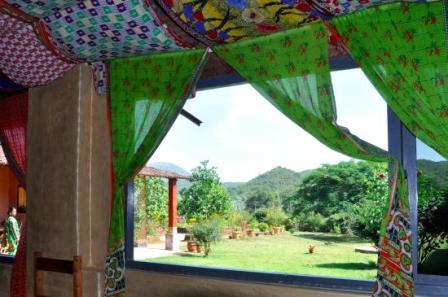Vinita Mitra*
The silence is broken with the sweet twittering of birds that merges with the clinking of cowbells in the distance. The poignant surrealistic feeling when you open your eyes to rumbling tribal drums deep in the mountains and the waft of fresh coffee fused with the aroma of freshly baked bread drenches the senses.

Far away from the madding crowd, intrinsically calm and lounging in a manicured lawn overlooking the undulating hills, nestles Chandoori Sai . Just 200 kms from the bustle of Vizag, this luxury guest house in Goudaguda, a pottery-producing village is a couple of kilometers from Kakiriguma in Koraput district of Odisha. Located at a height of 3,000 ft above the sea level, the temperature hovers pleasantly at about 25˚C in the morning to a comfortable 21˚C in the evening.

Chandoori Sai is run by a gentleman from Australia, who has made Odisha his home. Mr. Lyon Mahoney has set up this guest house with five double rooms in the beautiful environs of verdant green hills and endless sloping fields. The center of attraction is the potters’ village where the friendly potters welcome guests and eagerly exhibit their wares. The all-women staff in the guest house are the local tribal women who have learnt a smattering of English to communicate with the guests.

Lyon and his courteous helpers serve a lip-smacking continental cuisine. They make their own home-made pasta, freshly baked bread, pies and tarts for dessert and could give the best of bakeries a run for their money. Refreshing cups of lemon grass and ginger-infused tea are easily available, guests are welcome to use the kitchen and feel at home.

Located near Kakiriguma is the famous Kotpad village where weavers weave their magic using natural dyes, harvested in the deep forest by Muria, Koya, Bhatra, Gadaba, Paroja and other Adivasis. Women of Panika weavers’ families extract the red dye from the AUL or madder dye (Morinda Citrifolia) extracted from the root of the Indian Madder tree roots.

Kotapad cotton sarees have solid borders with paata anchals, duppattas with typical buties and motifs and stoles and dress materials dyed with vegetable dyes. The tribal weavers weave coarse cotton yarns ranging from 10 to 20 counts into varied products. Kotpad sarees are gorgeous and usually available in boutiques in Bhubaneswar and Kolkata and sell like hot cakes at double the cost.



The stay in Chandoori Sai is incomplete without a visit to the weekly haat. Even though modern life has made an entry in the form of television, mobile phones, motor bikes and solar panels, little has changed. The tribal villagers are simple people who work hard and love their mahuli and handia drinks, dancing away to the ethnic beats of the drums.
The author is a teacher at KiiT International School, Bhubaneswar.


Comments are closed.